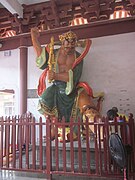Heng and Ha

Heng and Ha (
Novel
In the Investiture of the Gods, the Heng (哼) or Hengjiang (哼将; 'General Heng') is named Zheng Lun (郑伦; 鄭倫) and the Ha (哈) or Hajiang (哈将; 'General Ha') is named Chen Qi (陈奇; 陳奇), both are officials of guarding the grain in the Shang dynasty. Finally, Jiang Ziya canonized and added them to Feng Shen Bang's list (封神榜).[1]
Buddhism
In Chinese Buddhism, Heng and Ha are the common names of the jingang lishi,[2] two guards of Buddhist temples. They are usually placed on both sides of the Shanmen. They hold vajras (short metal weapon that has the symbolic nature of a diamond), namely "Narayana" (Buddha's warrior attendant) or "Yaksha Deity" (夜叉神) or "Zhi Jin Gang" (执金刚; 執金剛) in Chinese. The Vajra originally refers to the short metal weapon of king of all heavenly deities Indra in Indian Buddhist deities and symbolizes solidness and sharpness in Buddhism. Narayana is a Dharmapala who protects Buddhism with his Vajra in his hand.[4]
Originally, there was only one Narayana in Buddhism, after the introduction of Buddhism from
Gallery
See also
References
- ^ a b Xu Zhonglin & Lu Xinxing (2005), p. 709–718.
- ^ a b c "哼哈二将不同之处". hzcmc.com (in Simplified Chinese). 29 April 2020. Retrieved 13 December 2020.
- ^ "與畫中『哼哈二將』四眼相顧,驚喜就在其中!". fgsbmc.org.tw (in Traditional Chinese). 6 September 2020. Retrieved 13 December 2020.
- ^ a b c Zi Yan (2012), p. 25–26.
Bibliography
- Zi Yan (2012-08-01). Famous Temples in China. Beijing: Time Publishing and Media Co., Ltd. ISBN 978-7-5461-3146-7.
- ISBN 7-5325-3927-X.
Further reading
- Zhang Yuhuan (2012). 《图解中国佛教建筑》 [Illustration of Buddhist Architecture in China] (in Chinese). Beijing: Contemporary China Publishing House. ISBN 978-7-5154-0118-8.
- Wang Guixiang (2016-06-17). 《中国汉传佛教建筑史——佛寺的建造、分布与寺院格局、建筑类型及其变迁》 [The History of Chinese Buddhist Temples] (in Chinese). Beijing: Tsinghua University Press. ISBN 9787302427056.




